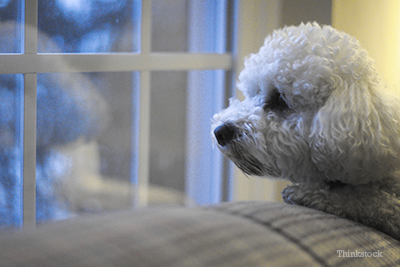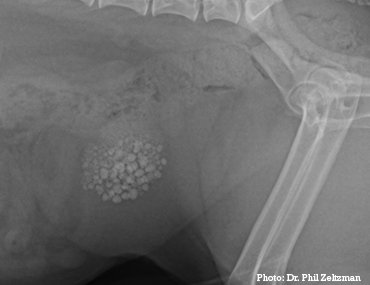Dr. Phil Zeltzman is a traveling, board-certified surgeon in Allentown, PA. His website is www.DrPhilZeltzman.com. He is the co-author of “Walk a Hound, Lose a Pound” (www.WalkaHound.com).
Chris Longenecker, a Certified Veterinary Technician in Reading, PA, contributed to this article.

Skippy suddenly started having “accidents” in the house. The picture of perfection, the 5 year old Bichon was urinating on the floor! Sally, his concerned owner, talked to her neighbor, who has a female Labrador who was doing the same thing a few months ago. She was diagnosed with a bladder infection and was treated with antibiotics. So Sally took Skippy to his family vet. Convinced that he had a urinary tract infection, she told the vet about Skippy’s behavior. The vet recommended a urinalysis and X-rays of Skippy’s belly “to be on the safe side.” Surprised, Sally declined the X-rays. After all, her neighbor’s dog only needed antibiotics. Sally “gently” demanded antibiotics instead.
A few days later, Skippy still had accidents, except that his urine turned bloody. Sally called her vet to schedule the radiographs… which revealed dozens of bladder stones! Her vet explained that surgery would be necessary to remove the stones. This is especially important before one stone travels down his urethra (the tube between the bladder and the outside world) and blocks it, thus preventing him from urinating. At best, this could lead to a painful and urgent condition. At worst, it could progress to a life-threatening situation.
Bladder surgery, also known as cystotomy, was scheduled for the next morning. Blood work was first performed to make sure Skippy was a good candidate for anesthesia, and to make sure his kidneys were healthy. Surgery involved opening the belly and the bladder to physically remove all the stones. A catheter was placed in the urethra during surgery to make sure no stone has been lodged there.
Two tests were then sent to the lab:
- a stone analysis, which determined what kind of diet will prevent the stones from coming back.
- a culture, i.e. a sterile swab, which indiciated whether there is an infection, and which antibiotic would take care of it.
Skippy went home and progressively felt better. Most bladder stones in cats and dogs are made of calcium or magnesium. The culture came back negative, which means that there was no bladder infection. The stone analysis revealed that they were made of calcium. Skippy was prescribed a special food and some supplements to try to prevent them from coming back.

In our experience, understanding the importance of the special food is the biggest challenge pet owners face. It is critical to understand that if your pet is prescribed a stone-prevention diet (or any other special diet for that matter), this should be the only food offered – for life.
We are trying to create a balance between the minerals. If you add anything to the mix, you will create an imbalance, which defeats the whole purpose. The unfortunate consequence is that your pet may very well end up with stones again, of the same type or not, and may very well need another surgery.
Skippy’s owner understood this important concept and to this day, the picture-perfect Bichon has been stone-free and leads a normal, happy life.
If you have any questions or concerns, you should always visit or call your veterinarian – they are your best resource to ensure the health and well-being of your pets.
